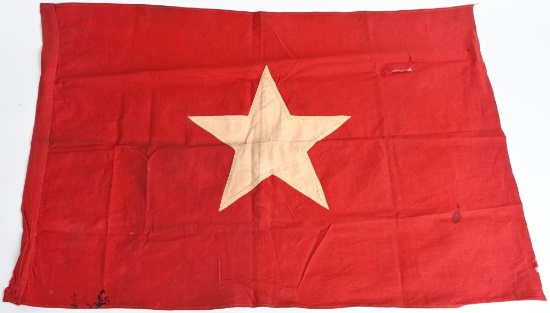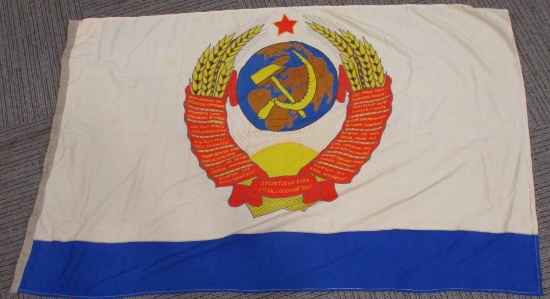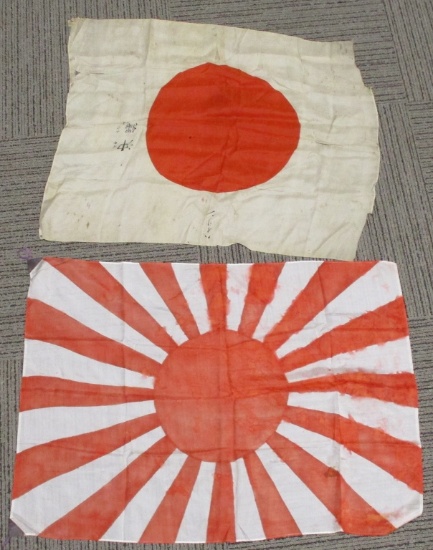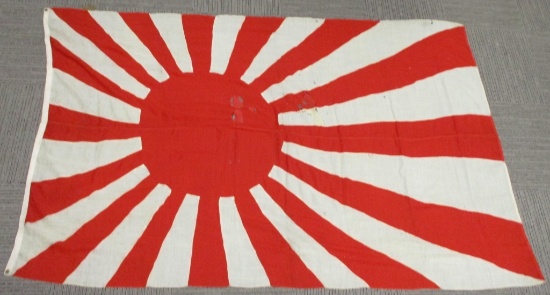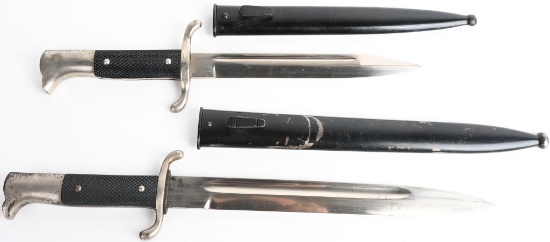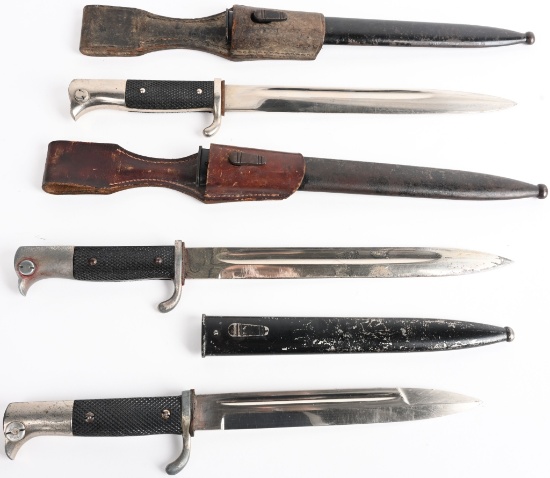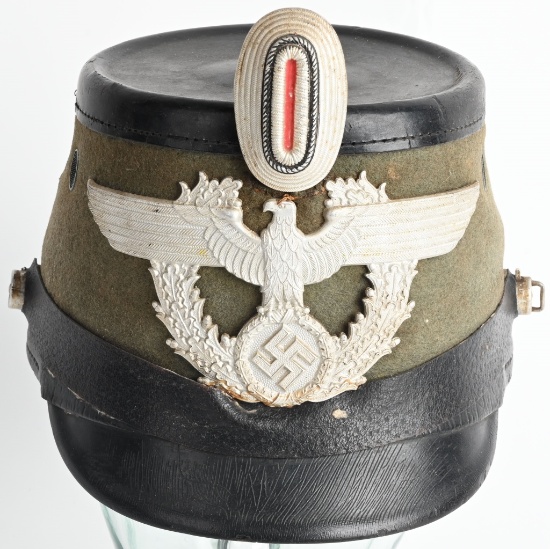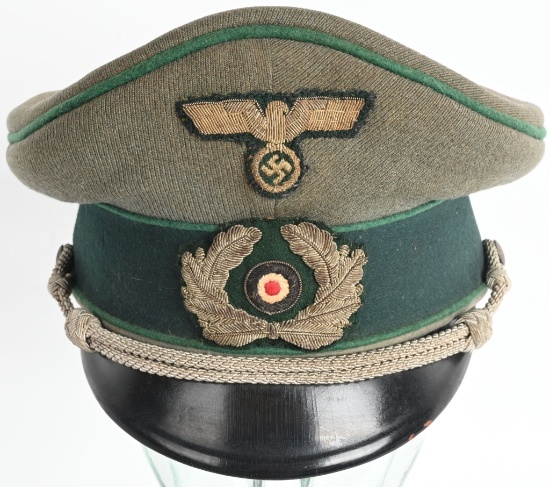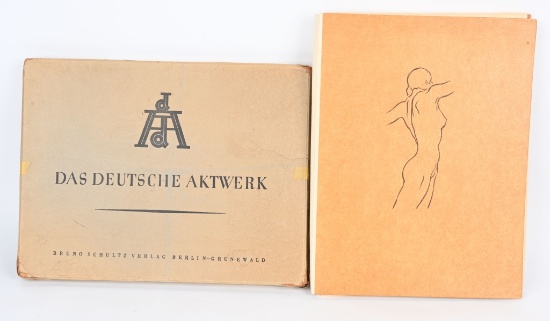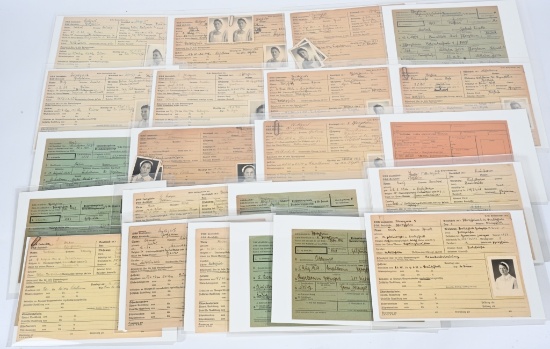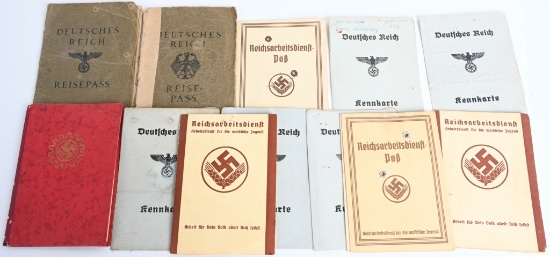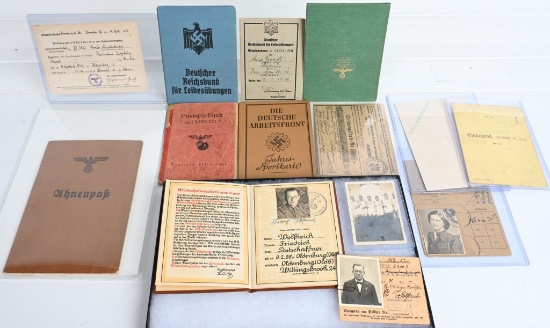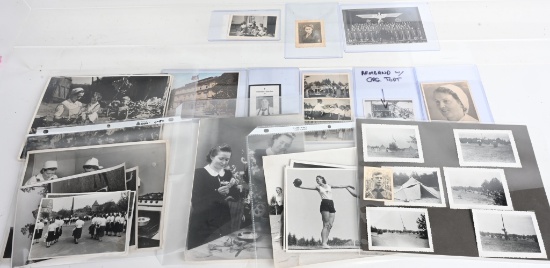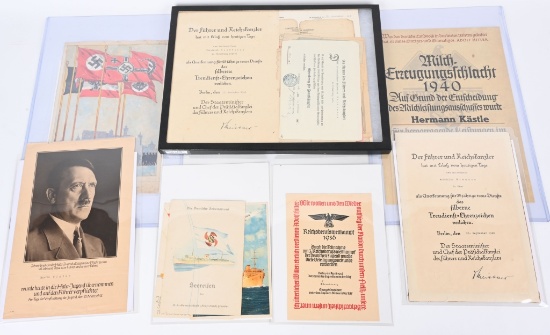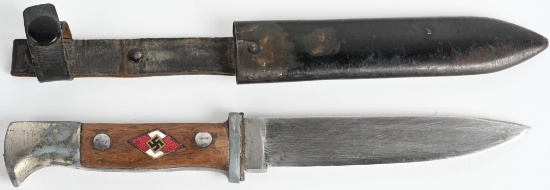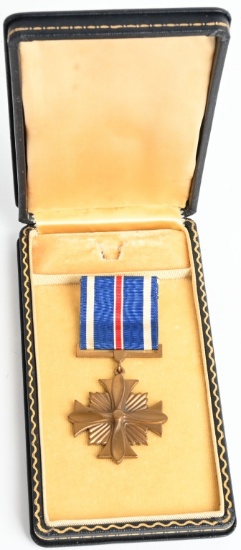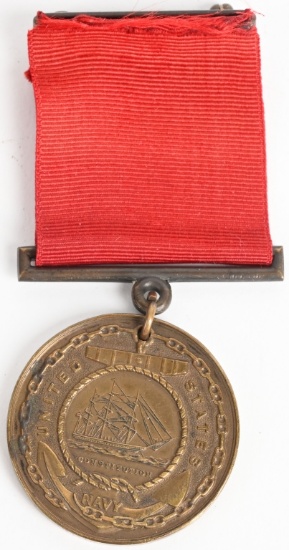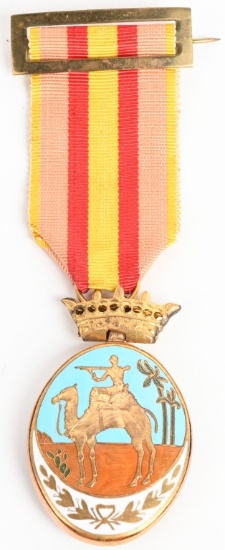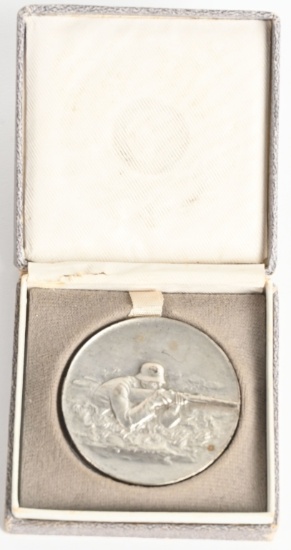Lot # 186 (Sale Order: 190 of 874)
Low Estimate: 300High Estimate: 400
WWII Nazi German ID Card booklets to include 1) CIVIL IDENTIFICATION CARD. A light grey oilcloth, half-fold, "Kennkarte" (Identity-card), whose closed cover measures 10.5cm x 14cm. Its cover features a black, spread-winged eagle with a wreathed, mobile swastika in its talons, with "Deutsches Reich," in Gothic script, above it and "Kennkarte" beneath. The first interior page has eleven blocks to it which relate the bearer's district, identity number, name, birth date and place, occupation, unalterable and alterable identifying features, and "Bemerkungen" (Observations). To the facing page is a black and white photograph of the bearer, right and left forefinger-prints, and official stamps and signatures. 2) CIVIL IDENTIFICATION CARD. A light grey oilcloth, half-fold, "Kennkarte" (Identity-card), whose closed cover measures 10.5cm x 14cm. Its cover features a black, spread-winged eagle with a wreathed, mobile swastika in its talons, with "Deutsches Reich," in Gothic script, above it and "Kennkarte" beneath. The first interior page has eleven blocks to it which relate the bearer's district, identity number, name, birth date and place, occupation, unalterable and alterable identifying features, and "Bemerkungen" (Observations). To the facing page is a black and white photograph of the bearer, right and left forefinger-prints, and official stamps and signatures. 3) CIVIL IDENTIFICATION CARD. A light grey oilcloth, half-fold, "Kennkarte" (Identity-card), whose closed cover measures 10.5cm x 14cm. Its cover features a black, spread-winged eagle with a wreathed, mobile swastika in its talons, with "Deutsches Reich," in Gothic script, above it and "Kennkarte" beneath. The first interior page has eleven blocks to it which relate the bearer's district, identity number, name, birth date and place, occupation, unalterable and alterable identifying features, and "Bemerkungen" (Observations). To the facing page is a black and white photograph of the bearer, right and left forefinger-prints, and official stamps and signatures. 4) DAF MEMBERSHIP BOOK. The 10.5cm x 15cm, sixteen page membership book has red patterned covers, to the front of which is stamped, in gold, the DAF emblem of a mobile swastika within a fourteen-toothed cog. To the inside page after, with the headings "Die Deutsche Arbeitsfront" and "Mitgliedsbuch" (Member's-book), details the personal information of the bearer. Various stamps and entries. 5) CIVIL IDENTIFICATION CARD. A light grey oilcloth, half-fold, "Kennkarte" (Identity-card), whose closed cover measures 10.5cm x 14cm. Its cover features a black, spread-winged eagle with a wreathed, mobile swastika in its talons, with "Deutsches Reich," in Gothic script, above it and "Kennkarte" beneath. The first interior page has eleven blocks to it which relate the bearer's district, identity number, name, birth date and place, occupation, unalterable and alterable identifying features, and "Bemerkungen" (Observations). To the facing page is a black and white photograph of the bearer, right and left forefinger-prints, and official stamps and signatures. 7) CIVIL IDENTIFICATION CARD. A light grey oilcloth, half-fold, "Kennkarte" (Identity-card), whose closed cover measures 10.5cm x 14cm. Its cover features a black, spread-winged eagle with a wreathed, mobile swastika in its talons, with "Deutsches Reich," in Gothic script, above it and "Kennkarte" beneath. The first interior page has eleven blocks to it which relate the bearer's district, identity number, name, birth date and place, occupation, unalterable and alterable identifying features, and "Bemerkungen" (Observations). To the facing page is a black and white photograph of the bearer, right and left forefinger-prints, and official stamps and signatures. 8) RADwJ LABOR SERVICE IDENTIFICATION PASS CARD. A single-fold, off-white cardboard "Arbeitsdienst-paß" whose closed cover measures 10.5cm x 14.5cm. The cover features, in brown, the title "Arbeitsdienst-paß", the RADwj logo of a mobile swastika with two sheaves of wheat underneath it, enclosed in a circle, and to the bottom "Reichsarbeitsdienst für die weibliche Jugend". To the first interior page is a double stamped photograph of the bearer in her uniform. The second page gives information on her service while on the back cover are outlined the rights entitled to the bearer of the card. 9) RADwJ LABOR SERVICE IDENTIFICATION PASS CARD. A single-fold, off-white cardboard "Arbeitsdienst-paß" whose closed cover measures 10.5cm x 14.5cm. The cover features, in brown, the title "Arbeitsdienst-paß", the RADwj logo of a mobile swastika with two sheaves of wheat underneath it, enclosed in a circle, and to the bottom "Reichsarbeitsdienst für die weibliche Jugend". To the first interior page is a double stamped photograph of the bearer in her uniform. The second page gives information on her service while on the back cover are outlined the rights entitled to the bearer of the card. 10) RADwJ LABOR SERVICE IDENTIFICAT
WWII Nazi German ID Card booklets to include 1) CIVIL IDENTIFICATION CARD. A light grey oilcloth, half-fold, "Kennkarte" (Identity-card), whose closed cover measures 10.5
...morecm x 14cm. Its cover features a black, spread-winged eagle with a wreathed, mobile swastika in its talons, with "Deutsches Reich," in Gothic script, above it and "Kennkarte" beneath. The first interior page has eleven blocks to it which relate the bearer's district, identity number, name, birth date and place, occupation, unalterable and alterable identifying features, and "Bemerkungen" (Observations). To the facing page is a black and white photograph of the bearer, right and left forefinger-prints, and official stamps and signatures. 2) CIVIL IDENTIFICATION CARD. A light grey oilcloth, half-fold, "Kennkarte" (Identity-card), whose closed cover measures 10.5cm x 14cm. Its cover features a black, spread-winged eagle with a wreathed, mobile swastika in its talons, with "Deutsches Reich," in Gothic script, above it and "Kennkarte" beneath. The first interior page has eleven blocks to it which relate the bearer's district, identity number, name, birth date and place, occupation, unalterable and alterable identifying features, and "Bemerkungen" (Observations). To the facing page is a black and white photograph of the bearer, right and left forefinger-prints, and official stamps and signatures. 3) CIVIL IDENTIFICATION CARD. A light grey oilcloth, half-fold, "Kennkarte" (Identity-card), whose closed cover measures 10.5cm x 14cm. Its cover features a black, spread-winged eagle with a wreathed, mobile swastika in its talons, with "Deutsches Reich," in Gothic script, above it and "Kennkarte" beneath. The first interior page has eleven blocks to it which relate the bearer's district, identity number, name, birth date and place, occupation, unalterable and alterable identifying features, and "Bemerkungen" (Observations). To the facing page is a black and white photograph of the bearer, right and left forefinger-prints, and official stamps and signatures. 4) DAF MEMBERSHIP BOOK. The 10.5cm x 15cm, sixteen page membership book has red patterned covers, to the front of which is stamped, in gold, the DAF emblem of a mobile swastika within a fourteen-toothed cog. To the inside page after, with the headings "Die Deutsche Arbeitsfront" and "Mitgliedsbuch" (Member's-book), details the personal information of the bearer. Various stamps and entries. 5) CIVIL IDENTIFICATION CARD. A light grey oilcloth, half-fold, "Kennkarte" (Identity-card), whose closed cover measures 10.5cm x 14cm. Its cover features a black, spread-winged eagle with a wreathed, mobile swastika in its talons, with "Deutsches Reich," in Gothic script, above it and "Kennkarte" beneath. The first interior page has eleven blocks to it which relate the bearer's district, identity number, name, birth date and place, occupation, unalterable and alterable identifying features, and "Bemerkungen" (Observations). To the facing page is a black and white photograph of the bearer, right and left forefinger-prints, and official stamps and signatures. 7) CIVIL IDENTIFICATION CARD. A light grey oilcloth, half-fold, "Kennkarte" (Identity-card), whose closed cover measures 10.5cm x 14cm. Its cover features a black, spread-winged eagle with a wreathed, mobile swastika in its talons, with "Deutsches Reich," in Gothic script, above it and "Kennkarte" beneath. The first interior page has eleven blocks to it which relate the bearer's district, identity number, name, birth date and place, occupation, unalterable and alterable identifying features, and "Bemerkungen" (Observations). To the facing page is a black and white photograph of the bearer, right and left forefinger-prints, and official stamps and signatures. 8) RADwJ LABOR SERVICE IDENTIFICATION PASS CARD. A single-fold, off-white cardboard "Arbeitsdienst-paß" whose closed cover measures 10.5cm x 14.5cm. The cover features, in brown, the title "Arbeitsdienst-paß", the RADwj logo of a mobile swastika with two sheaves of wheat underneath it, enclosed in a circle, and to the bottom "Reichsarbeitsdienst für die weibliche Jugend". To the first interior page is a double stamped photograph of the bearer in her uniform. The second page gives information on her service while on the back cover are outlined the rights entitled to the bearer of the card. 9) RADwJ LABOR SERVICE IDENTIFICATION PASS CARD. A single-fold, off-white cardboard "Arbeitsdienst-paß" whose closed cover measures 10.5cm x 14.5cm. The cover features, in brown, the title "Arbeitsdienst-paß", the RADwj logo of a mobile swastika with two sheaves of wheat underneath it, enclosed in a circle, and to the bottom "Reichsarbeitsdienst für die weibliche Jugend". To the first interior page is a double stamped photograph of the bearer in her uniform. The second page gives information on her service while on the back cover are outlined the rights entitled to the bearer of the card. 10) RADwJ LABOR SERVICE IDENTIFICATless...



 x Cancel
x Cancel